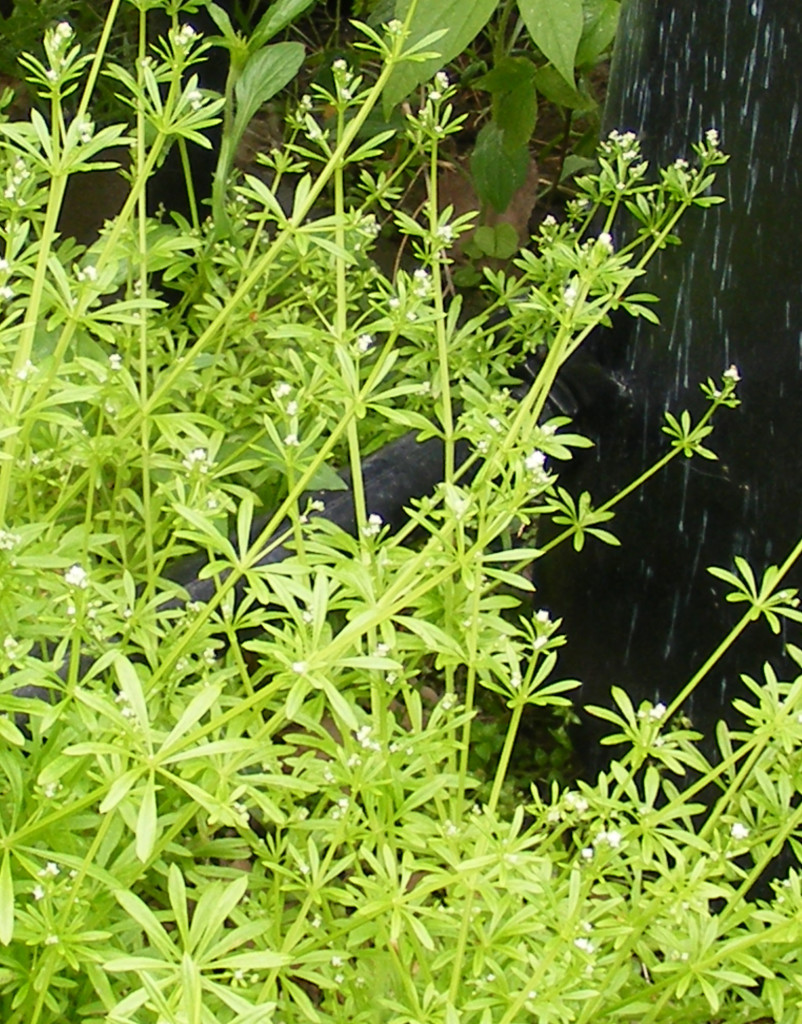
Goosegrass is a short-lived winter edible. Photo by Jeremy Sell.
The goose is on the loose, Goosegrass that is and you have to look quick or it will be gone. If there’s an edible that seems to be around even less time than Pellitory or Chickweed, it’s Goosegrass, a fleeting forageable of spring. Also called Cleavers and Bedstraw, it’s distantly related to coffee. I saw my first patch of it Saturday while teaching a class just south of Daytona Beach. Generally we see two common species locally, one with edible tips and one whose roots were used for red dye. To separate the edible from the dye plant you only need to count to seven. That and the fact that one is a natural Velcro and sieve. To read more about Goosegrass go here.
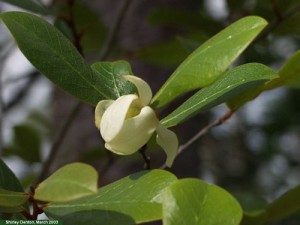
Blossoming pawpaw, photo by Shirley Denton who has been photographing Florida wildlife for many years.
Now is the time to locate pawpaw bushes. In Florida pawpaw are runts of the genus so to speak. Farther north they are trees you have to look up to find. Here, one usually has to look down. We have shrub-sized pawpaws and dwarf ones that barley reach knee height. And, just as soon as they ripen the denizens of the woods eat them, after all it is their grocery store. While you can find pawpaws nearly everywhere (except swamps) the most common places I find them are at the base of tall pines trees in scrub area (I presume that is where the creatures eat them, or in the tree above) and in pastures. In fact in the month to come one can often drive by a pasture and see three or four foot high spindly shrubs with white magnolia-like blossoms. Those are pawpaws. Maybe the livestock distribute the seeds in pastures, or perhaps gopher tortoises. To read more about pawpaws, or papaws, go here.
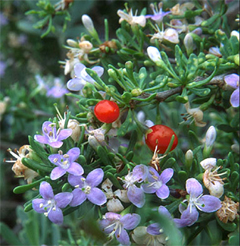
Christmas Berry, photo by Roger Hammer
Our local Goji Berry is also blossoming. We saw some flowers and a few early berries during the aforementioned foraging class near Daytona Beach. Interestingly it’s in the nightshade family as is its famous relative, the true Goji Berry. Our local version is Lycium carolinianum, better known as Wolf Berry and Christmas Berry. There are several edible ‘Christmas’ berries in Florida so don’t just go by the common name. More so Lycium carolinianum also does not fruit anywhere near Christmas but rather around April. It’s also salt tolerant and favors coastal areas should you need an edible shrub for landscaping. To read more about our “Goji” berry go here.
Botany Builder #22: Stipule. A stipule is an outgrowth arising at the base of the leaf stem (petiole.) They can be modified into hairs, glands, spines and tendrils. Often they are an element of identification. The edible Skunk Vine has two stipules at each node though sometimes they wear off or grow old and drop off so you have to look at several nodes. In the picture at left between the leaf stems you can see a triangle-shaped growth. That is a stipule (STIP-yewl.) The Skunk Vine also has one on the other side. Besides the vine’s aroma the stipule is one of the identifying characteristics of the species (in a state that has a lot of vines with opposite leaves.) To read more about the Skunk Vine, go here.
Researchers have studied the “unconscious selection and the evolution of domesticated plants” and discovered two things, one of which we would expect. That was that growers select traits they are interested in, such as a sweeter berry. The other “selection” was more covert. Taking plants from their original wild habitats and putting them in new and usually very different human-made or human-managed environments can automatically lead to drastic changes in the plants.
“Numerous adaptations vital for survival in the wild environments lost their fitness under the new sets of conditions,” said the researchers.* The wild plants in domestic environments showed new traits resulting in a build up of “domestication syndromes.” For foragers this suggests two things. If you want the wild plant to stay the same collect the seeds in the wild annually and use them once. The other option is to collect wild seed, cultivate the species, and then keep cultivating it with the domestic seed and see what happens which is where many of our food crops came from. A recent example is Apios americana, the ground nut. The University of Louisiana took wild Apios out of the swamp and developed larger domestic varieties for the common garden. To read more about ground nuts click here. *Journal of Economic Botany 58(1):5-10.
New articles: An edible oriental import that is invasive in parts of North America, the Chocolate Vine.
I haven’t used this because I don’t have an Iphone or Ipad (I still have a simple clam shell.) The USDA Forest Service has an iPhone/iPad app designed to help southern forest land owners and managers identify and manage non-native invasive plants in the field. No doubt there should be some edibles among the invasive lot.
It’s the first ever iPhone/iPad application developed by the world’s largest forest research organization. The app was funded by a grant and is based on the popular SRS publication A Field Guide for the Identification of Invasive Plants in Southern Forests and a companion management guide.
To download the free app go here. You can also use the following links to access and print the field guides. They are huge files and open far better in Safari than Firefox. A Field Guide for the Identification of Invasive Plants in Southern Forests is here. A Management Guide for Invasive Plants in Southern Forests is here. The latter two pages look almost identical, double check the titles.
Speaking of apps, there is also one for Iphones and Androids on invasive animals and plants of Florida. IveGot1 was developed by the University of Georgia Center for Invasive Species and Ecosystem Health through a cooperative agreement with the National Park Service, in cooperation with the Florida Fish and Wildlife Conservation Commission and the University of Florida Center for Aquatic and Invasive Plants. The features are: Easy species reporting that captures your current location and allows you to submit an image of your sightings. IveGot1 allows for both online and offline reporting with reports saved on your phone for uploading when you have network connectivity. It has images and information on Florida’s worst non-native invasive animals and plants. Real-time point distribution maps are centered on your current location. To learn more about it go here.
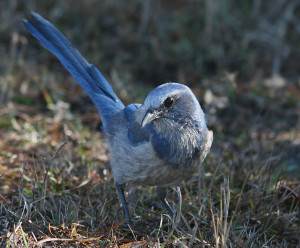
Florida Scrub Jay, photo by 10,000 Birds.
Totally off topic but related is the bird life we spied during the foraging class in Melbourne Sunday. We actually saw three Scrub Jays, Aphelocoma coerulescens, a threatened species. They were quite noisy and busy. Scrub Jays are naturally tame enough to eat food out of your hand. Unfortunately as their habitat becomes suburbia their numbers have been dropping. They are the only native bird found only in the state of Florida. Scrub Jays look similar to Blue Jays but are missing the head crest. They also appear to be a bit plumper… then again, it was a chilly day. To read more about the Scrub Jay go here.

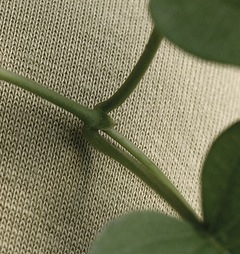
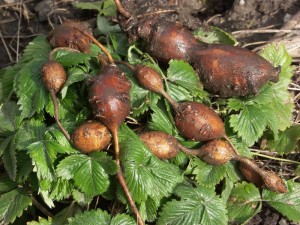
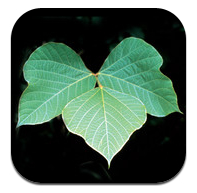
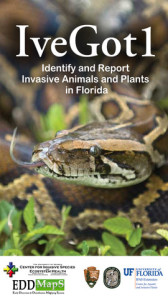

I didn’t realize we had our own “goji” berries in Florida. I’ll need to keep my eyes open… that would be a cool find. I spent part of this last weekend at John U. Lloyd park down south and was struck by how many edible varieties of plants were near the shore. Hog plums, sea grapes, coconuts, tropical almonds, sea beans, etc. The southern half of the state has it really good – even at the beach! I grew up down there but have only come to really appreciate it as an adult.
(On pawpaws: I’m working on wrapping up an extensive interview with the owner of Pietro’s PawPaws, a gal that propagates most of our native FL varieties… hopefully I can get that posted this week. When I do, I’ll share it with you. The many excellent photos she’s provided would be really good for ID purposes.)
I love your newsletters! We homeschool and I share them with our homeschool forum. The information is perfect for us, since we live in Florida, we get out a lot to the parks and sanctuaries, this give us ‘real world’ educational opportunities. Don’t worry, we are not tasting and harvesting yet, as we are novice, although we do steal a few beauty berries. But your plant and animal identification and habitat descriptions are easier to digest, a little bit week by week. This coming Thursday we will be adventuring back out to the Cypress swamps of the western Everglades to explore the Fakahatchee Strand State Park with renowned biologist, Mike Owens. We joined the ECO (Every Child Outdoors) Nature Classes (thenatureteacher.com)!
Dean, are you aware of any similar apps that would apply to the Northeast?
Google Steve Brill app
mr dean how are u how many palm tree seed could eat
I not to lone start watching show an I love it already I boil many bushes for tea but never pine needle, am learning much from u already
and dandelion an many other weeds I saw in my yard.am thinking twice to eat them
No… perhaps I should a page of them together.
I was hoping my rampant weed was goosegrass, but appears not. Shortish growth. Onthe tip of each stem it has five petioles, each has 3 petioles which each have 3 or 5 petioles. Can you advise me how to identify?
The following experiment may be suitable to exemplify the effect of the change in moving a plant grown in wild habitat to a new environment. I have transferred a well grown pot planted blossoming, Cestrum Nocturnum (emits lovely fragrance by night) from a locality of shade, cooler and mild breeze conditions to be closer to the window of my room – change in temperature, pressure and more important sunlight. Within the first three days a drastic change took place:fading and falling of flowers and leaves. However, after nearly three weeks I observed advent of younger green leaves ;but no sign of flowers. With respect to the Scrub Jay, it has been reported that West Nile Virus is also one of the threats to these lovely birds. The Craw ,though not as lovely as the Scrub Jay, has got behaviour in common. They were once a nuisance to the community of Port Sudan city (main port of Sudan on the western coast of the Red Sea) nesting with whatever material on every tree in houses and streets, squaking loudly specially when gathering to mourn a dead one in the early morning.Should a lady loses part of her jewellery, she would be advised to look for it in the nearest nest of a craw. They have recenly diminished in number. It is claimed this is due to many of them flying away from the city towards the port itself because the city is nowadays witnessing intensive development. On the contrary pigeons of Mekka al Mukurrama (focus of muslim pilgrims in Saudi Arabia) have been higly ranked and honoured by virtue of the religous role a pair of their ancestors had played in “higrat” i.e. migration of Prophet Muhammad (peace be upon him) from Mekka to Medeena. they are well fed day and night;even repelling them to leave their place is considered sinful here. Consequently they are prolific safe and very freindly.
I tried the app. On one hand it is useful with multiple photos of any given “invasive species”. On the other hand, it is laughable in its ignorance of edibles. Garlic mustard, for example, is listed as having “no known value”. Same goes for bamboo.
Note that their focus is on the invasive, so native edibles aren’t listed. Also, because the word “edible” isn’t contained in this app, you would need to know in advance that, say, garlic mustard is edible and then use this app to help you identify it.
“Wildman” Steve Brill’s app is somewhat useful, but the free version keeps crashing on me every few minutes. I haven’t tried the paid version. The free version offers a “study” and a “quiz”. The quiz works for me in the iPhone 4; you are asked to identify an image of an edible from one of three choices. (Photo of lady’s thumb and choices of lady’s thumb, marsh mallow and perilla… nothing particularly challenging for the dedicated Green Deane subscriber.) It’s the “study” part, or flashcards, that crashes on me.
-cw
thanks for the report…
Love the bit about goosegrass. Just prior to your bit I taped a segment about goosegrass for Cooking Wild Television Show. I have found some beauty patches in Ocean Springs, MS, and also Gautier, MS. The goosegrass is now growing where I was harvesting chickweed just a little while back. I also get a lot of questions while I am foraging and/or taping show segments. I refer a lot of people to your site. Keep up the good work. I hope you can come to coastal Mississippi for a visit as there are a couple of good sites locally for your plant walks Best wishes for the new DVD set, I wonder if most folks realize what a lot of work taping and editing such a massive project becomes.